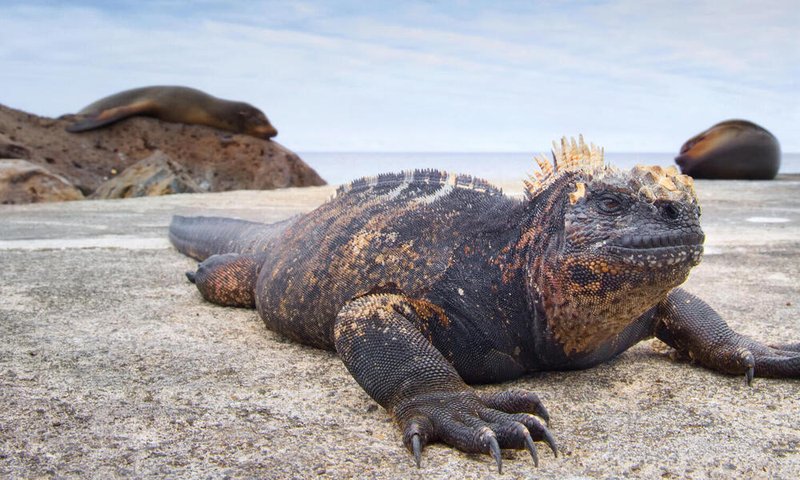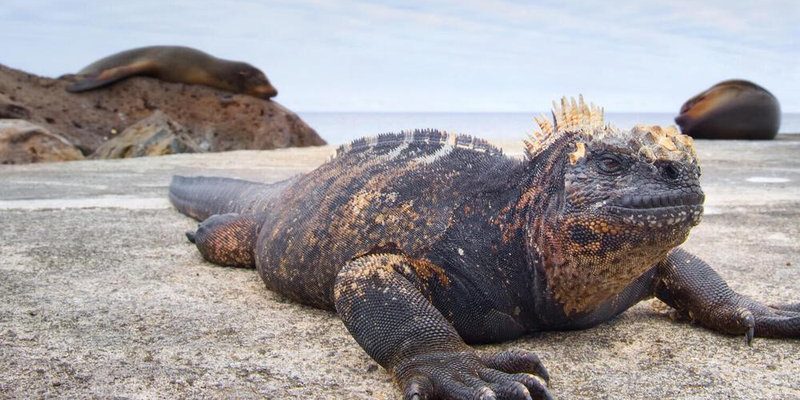
Let’s dive into some common myths and facts about the marine iguana. If you’re new to these creatures or just curious about what makes them tick, don’t worry; I’ll break it down for you in simple terms. So grab your favorite drink, and let’s explore the truth behind these remarkable reptiles!
Myth 1: Marine Iguanas Are Just Like Any Other Iguanas
You might think that all iguanas share similar traits, but the marine iguana is a whole different beast—literally. While they belong to the same family as land iguanas, they’ve adapted uniquely to life by the sea.
Here’s the thing: marine iguanas can swim! They often dive into the ocean to feast on algae, using their sharp claws to cling to rocks while they nibble away. Their dark, rugged skin helps them absorb heat from the sun, a key factor for their survival in cold waters. Other iguanas stick to a land-based diet; the marine iguana is a true ocean-going lizard.
Many people get confused and think they can be kept as pets like other iguana types. But these creatures are not cut out for life in a terrarium. Their specialized diet, habitat requirements, and social behaviors make them unique to their environment.
Myth 2: Marine Iguanas Are Dangerous
When you hear about creatures that can swim and dive, it’s easy to jump to conclusions about their danger level. But here’s where we clear the air: marine iguanas are not dangerous to humans at all.
Honestly, they’re quite docile. You might see them lounging on the rocks and soaking up the sun, which is part of their daily routine. They’re more interested in avoiding humans than being aggressive. It’s important to remember that they’re not predators; they don’t have sharp claws or teeth for attacking. They mainly focus on munching on algae, which makes them peaceful beach-goers.
Some folks worry about their size or intimidating look, but marine iguanas are far more likely to run away than to confront you. They prefer not to disturb their sunny spots and will retreat if they feel threatened.
Fact 1: Marine Iguanas Have Specialized Adaptations
What makes marine iguanas so special isn’t just their ability to swim; it’s how their body has evolved to meet the challenges of their environment.
Let me explain: marine iguanas can expel salt through their noses. When they dive into the ocean for algae, they inevitably inhale some salty water. Their body has evolved to filter that salt out, which is crucial for their health. It’s a bit like having a built-in water filter!
Additionally, these iguanas have a flat tail that aids in swimming. When they wiggle through the water, it’s almost like they’re using a paddle. This adaptation helps them reach the underwater plants they love to eat.
Their darker skin also plays a crucial role, absorbing heat from the sun more effectively after their chilly ocean swims. These adaptations make them perfectly suited for their habitat.
Myth 3: Marine Iguanas Are Solitary Creatures
While it might appear that marine iguanas are loners basking on rocks, they actually have a social structure and are generally found in groups.
You see, here’s the catch: during mating season, males can be quite territorial and may engage in some aggressive posturing to claim their space. But for the most part, they tend to gather in large numbers. You might find them sunbathing together, which helps them conserve body heat and is a part of their social behavior.
This communal lifestyle helps them feel more secure. Being in a group can reduce the chance of predation from birds and other threats. They often rely on each other to stay vigilant. It’s fascinating to see how social dynamics come into play even among reptiles.
Fact 2: Marine Iguanas Face Environmental Challenges
Despite being uniquely adapted to their environment, marine iguanas don’t have it easy. They face numerous challenges that threaten their survival.
Let’s break it down: climate change impacts their food sources, particularly the availability of algae. As ocean temperatures rise, the types of algae they rely on may shift, impacting their diets. This could lead to malnutrition or starvation for these creatures.
Additionally, human activity poses risks. Tourism, habitat destruction, and pollution all contribute to the challenges marine iguanas face. They are already a vulnerable species, and these threats can push them further toward endangerment if we aren’t careful.
The conservation efforts focused on protecting their habitats are essential for ensuring these extraordinary creatures can continue to thrive.
So there you have it! Whether you’re drawn in by their unique swimming abilities, their fascinating adaptations, or their social nature, marine iguanas are truly remarkable creatures. They remind us of how diverse and complex life can be, even in unexpected places like the rocky shores of the Galápagos Islands.
By understanding the myths and facts surrounding marine iguanas, we can appreciate them more fully. It’s crucial to support conservation efforts to protect their habitats so future generations can enjoy these incredible reptiles. Let’s respect their space, learn from their ways, and help ensure their survival in our ever-changing world. Remember, the more we know, the better we can appreciate and protect our planet’s unique wildlife.

